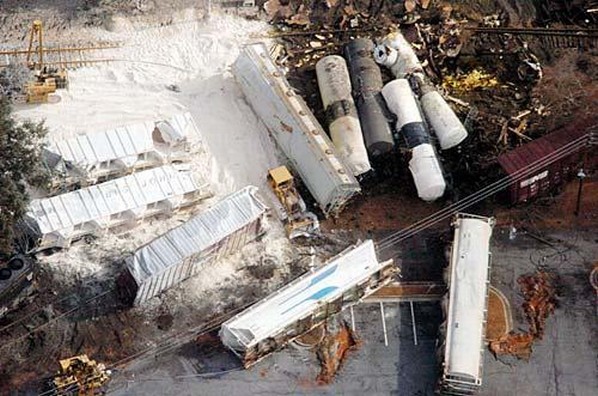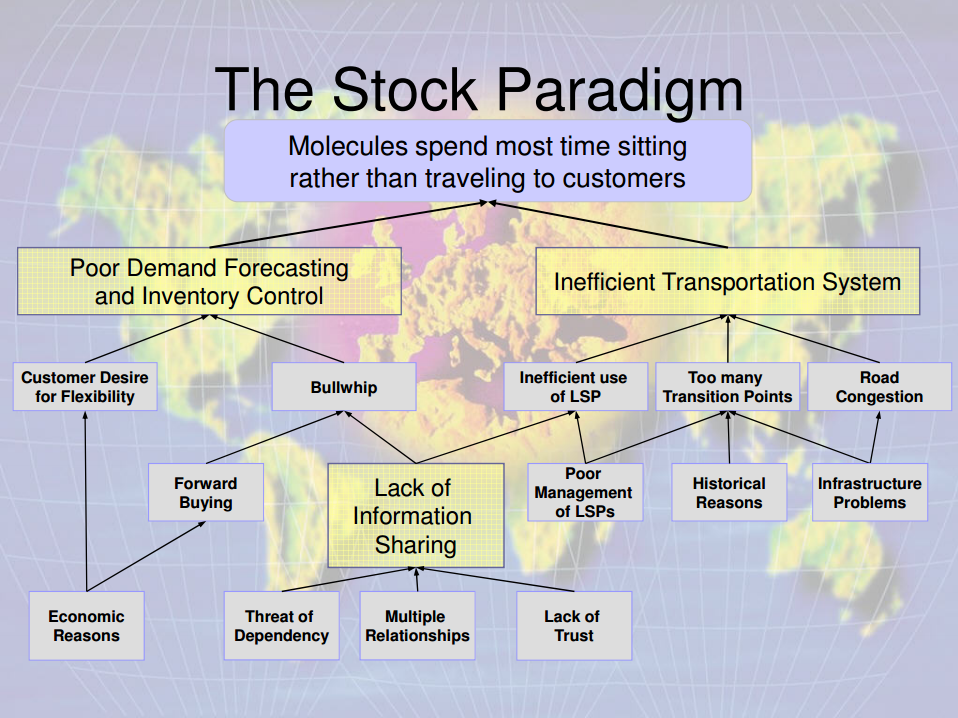
Graniteville Derailment (Source: EPA)
The recent leakage of the chemical 4-methylcyclohexane methanol (MCHM) from a storage tank owned by Freedom Industries Inc. into the Elk River in West Virginia once again highlighted the importance of handling and transporting hazardous chemicals safely. That spill affected hundreds of thousands of people in several states as the contaminated water moved down the river. Storing hazardous materials can be challenging; but, transporting such materials presents an even greater challenge. As an article in Inbound Logistics notes, “Getting the right product to the right place at the right time while controlling costs is a tough job for any shipper. When the product you handle is corrosive, combustible, poisonous, temperature-sensitive, or otherwise finicky about its environment, the challenge grows even tougher.” [“Chemical Logistics: Shippers/Providers Achieve Perfect Chemistry,” June 2012] The fallout that results when something goes wrong in the chemical supply chain are never pretty: lives are lost or permanently affected, lawsuits are filed, reputations are ruined; and companies can go out of business.
The causes of disasters in the chemical supply chain are numerous. In the Freedom Industries case, the root cause may have been neglect. According to some sources, the leak came from a storage tank that hadn’t been inspected by regulators in a dozen years. Human and mechanical errors can also cause such disasters. Back in 2005, a Norfolk Southern train “was diverted by an improperly lined railroad switch” onto a siding that contained another Norfolk Southern train near Graniteville, SC. The ensuing crash and derailment released toxic chlorine into the atmosphere. Nine people died and over 250 were treated for chlorine exposure. [“Graniteville, South Carolina, train crash,” Wikipedia] That single incident ended up costing nearly a quarter of a billion dollars and resulted in the closing of a local textile manufacturer that put 4000 people out of work. Train derailments continue to be of concern.
Russell Gold and Lynn Cook report that, since the middle of 2013, trains carrying Bakken Crude from oil fields in North Dakota have been involved in three accidents that have resulted in “major explosions.” One of those incidents, “a July [2013] accident in Lac-Mégantic, Quebec, … incinerated the downtown and left 47 people dead.” [“Cities Grapple With Oil-Train Safety,” Wall Street Journal, 14 January 2014] “Functioning as pipelines on rails,” they write, “tanker cars full of oil pass through Detroit, Philadelphia, Toronto, St. Louis, Kansas City and Houston, among others.” These incidents are tragic and totally unacceptable. As a result, the government and the rail industry are trying to address some of the issues involved. [“U.S. Officials Call For More Safety For Oil By Rail,” by Matthew Brown, Associated Press, 17 January 2014] The Inbound Logistics article continues:
“One issue that sets chemical logistics apart from many other logistics disciplines is the potential danger posed by the cargo. ‘Transporting chemicals presents unique shipping requirements because of the inherent danger and potential impact on health, safety, security, and the environment (HSSE),’ says Chris O’Brien, senior vice president at Eden Prairie, Minn.-based 3PL C.H. Robinson Worldwide, Inc., which provides transportation management solutions to chemical manufacturers through its ChemSolutions division. Concerns about HSSE demand that chemical shippers comply with a slew of safety regulations beyond those that apply to shippers in general. The requirements start with federal rules for transporting hazardous materials. Vehicles hauling hazmat loads must carry placards to indicate their contents — for example, a toxic gas, a flammable liquid, or an explosive. … In addition to federal safety regulations, hazmat shippers also must comply with rules that vary as their loads cross state lines.”
From that description of some of the compliance issue involved in the handling and transportation of hazardous material, it should be quite apparent how complex things can get. That’s why I believe that a cognitive computing system, like Enterra Solutions® Cognitive Reasoning Platform™ (CRP) can play a valuable role in improving safety. A cognitive computing system can integrate more information (e.g., state and federal regulations, traffic patterns, weather, road conditions, population densities, maintenance records, licenses, etc.) and do it much faster than humans. Because a cognitive computing system can gather and integrate data better than a team of humans, it can benefit six areas that have demonstrated their value in helping organizations make better decisions. Those areas are: reducing hazards; minimizing exposure; using best available information; requiring disclosure and transparency; resolving trade-offs; and, taking action.
Back in 2002, a team of seven students from Stanford University and Eindhoven University (NL) conducted a study they entitled “Bulk Chemical Supply Chains: Moving from Stock to Flow.” The team concluded that “molecules spend most [of their] time sitting rather than traveling to customers.” This was a result of “poor demand forecasting and inventory control” coupled with an “inefficient transportation system.” They graphically present this information in the following image.

They concluded that the situation could be dramatically improved using smarter inventory control, better information sharing, and more centralized management of logistics services. Each of these areas could be improved by utilizing a cognitive computing system to improve decision-making. The use of cognitive computing systems to increase supply chain safety could actually begin long before chemicals need to be stored or transported.
An article published by the Safer Chemicals, Healthy Families coalition states, “Leading businesses are redesigning their products and working with their suppliers to reduce the use of toxic chemicals. Companies in the healthcare, building, retail, electronic and cleaning product sectors are at the forefront of this movement.” [“The Business Case for Comprehensive TSCA Reform“] Cognitive computing systems could help chemical companies develop safer products or identify safer alternatives to materials currently being used. The press release announcing the winners of the 2013 Nobel Prize for chemistry stated, “Chemists used to create models of molecules using plastic balls and sticks. Today, the modelling is carried out in computers. … Today the computer is just as important a tool for chemists as the test tube. Simulations are so realistic that they predict the outcome of traditional experiments.” [“The computer – your Virgil in the world of atoms,” The Royal Swedish Academy of Sciences, 9 October 2013]
We can’t escape the need for chemistry or chemicals in our daily lives. John Replogle writes, “Virtually all of the materials we need and the luxuries we enjoy rely in some way on this remarkable science.” But, he notes, we are only learning the long-term effect of many of these chemicals on the human body and the environment. [“We need regulation to remove chemicals from the supply chain,” The Guardian, 20 December 2013] Replogle insists that we can continue safely to enjoy most of the products we use today by using non-toxic substitutes. Obviously, transporting and storing non-toxic substances would also make the entire supply chain safer. Replogle notes that Walmart and Target are starting to work with their suppliers to find such alternatives.
Admittedly, however, we are not going to be able to eliminate all hazardous materials from the supply chain. Therefore, every effort needs to be made to ensure that hazardous materials are stored and transported safely. Cognitive computing systems can help ensure a safer supply chain. They can balance more factors, make more connections, offer clearer insights, and make better recommendations than their human counterparts. Since computers don’t suffer from fatigue or stress, cognitive computing systems are likely to make fewer errors as well. Since they are learning systems, the more information they ingest the better their contribution will be. From the creation of new products to the stock and flow of chemicals in the supply chain, cognitive computing systems are likely to have a significant impact in the years ahead.




